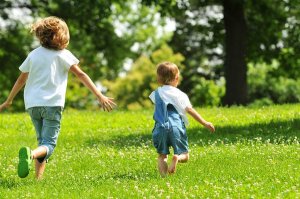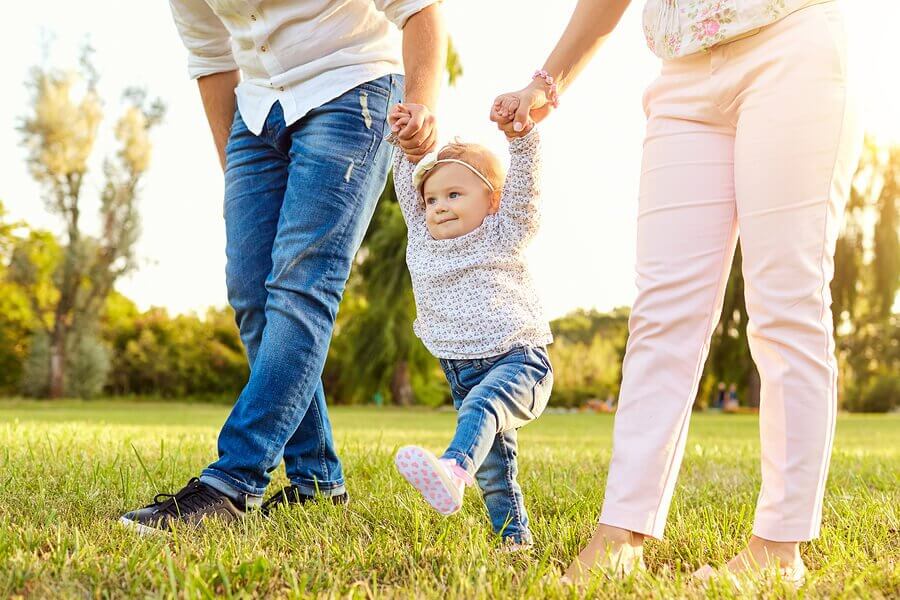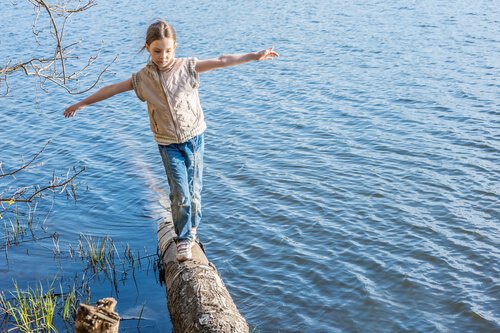Importance of Movement for Child Development

Children communicate through movement. Movement allows them to relate to their environment, and grow both physically and mentally. In this article, we’ll explain the importance of movement for child development.
As babies grow up, they discover how different parts of their bodies move. For the first few months, they put everything in their mouths. They start to become aware of their movements, and continue to explore how their actions affect their environment. Little by little, they’re building their world.
Additionally, through movements in the form of games, they gain experience and knowledge, which reinforces and enhances their motor coordination. That’s why moving is so important for child development.
Motor activity allows different parts of the brain to develop. In the first few years of life, it’s very important for children to move as much as possible. In that sense, physical exercise contributes to their physical, mental and emotional growth.
Physical activity also helps strengthen breathing, circulation, and the muscular, cardiovascular and nervous system. It allows them to have concrete experiences that help their intellectual development, independence and social adaptation. All of this helps kids grow healthily and happily.
What’s more, this type of exercise strengthens kids’ ability to overcome difficulties, as well as benefits their physical and mental growth. Because of all of this, sports, games and activities are vital for child development.

Movement for child development: activities
There are several types of exercises and activities that parents and children can do together. Parents can help their children do different exercises to help with their development.
It’s essential for children to take their time doing an activity, and that parents patiently support them in the process.
- Encourage them to crawl. This simple first step helps the parts of their brain that control movement grow and develop.
- Go for a walk. Make sure to go at your children’s pace. This way, they’ll reinforce laterality skills, which are necessary to read and write.
- Teach them to work on their balance. Kids can go on the swings, ride bikes, roller skate, and more. This helps them improve their posture and not get tired as easily.
- Do outdoor motor coordination activities with them. For example, together, you can jump, run, and play catch. In fact, this will help them develop better at school.
- Show them how to organize or store objects. This helps them develop fine motor skills, which are a crucial part of child development.
- Teach them how to tie their shoes. This helps their early development and logical reasoning.
- Put them in dance class. This hobby helps them develop muscles all over their body.
Importance of sports
Sports are essential for children to exercise larger movements and develop properly. In addition, these activities also help them relate more easily to others, as well as strengthen different parts of their bodies, such as:
- Psychomotor development: Helps cardiovascular activity, as well as helps bones form.
- Body development: Find out what kinds of sports are best for your child’s body type and age. Of course, you should do this with a specialist. Additionally, make sure to ask your child what kinds of sports he’s interested in.
- Development of skills and behaviors: It’s essential to teach kids the importance of certain values, like intelligence, honesty and respect.

“Motor activity allows different parts of the brain to develop. In the first few years of life, it’s important for children to move as much as possible. Physical exercise contributes to their physical, mental and emotional growth.”
Psychomotricity: what it is and how it influences child development
Psychomotricity is the relationship between the neuromotor functions and mental functions. Thanks to this, movement connects physical and mental activity. Therefore, it stimulates kids’ ability to solve problems and make decisions.
Because of this, babies that want to get a toy on the other side of the room will figure out how to get to it by crawling. Also, during child development, when kids learn new motor skills, such as jumping and running, they feel more secure and confident. By mastering these skills, they’ll be very proud of themselves.
Now that you know the importance of movement for child development, you need to help your children develop their motor skills. This way, their brains will mature. Also, when they’re older, it’ll be easier for them to learn new skills.
Children communicate through movement. Movement allows them to relate to their environment, and grow both physically and mentally. In this article, we’ll explain the importance of movement for child development.
As babies grow up, they discover how different parts of their bodies move. For the first few months, they put everything in their mouths. They start to become aware of their movements, and continue to explore how their actions affect their environment. Little by little, they’re building their world.
Additionally, through movements in the form of games, they gain experience and knowledge, which reinforces and enhances their motor coordination. That’s why moving is so important for child development.
Motor activity allows different parts of the brain to develop. In the first few years of life, it’s very important for children to move as much as possible. In that sense, physical exercise contributes to their physical, mental and emotional growth.
Physical activity also helps strengthen breathing, circulation, and the muscular, cardiovascular and nervous system. It allows them to have concrete experiences that help their intellectual development, independence and social adaptation. All of this helps kids grow healthily and happily.
What’s more, this type of exercise strengthens kids’ ability to overcome difficulties, as well as benefits their physical and mental growth. Because of all of this, sports, games and activities are vital for child development.

Movement for child development: activities
There are several types of exercises and activities that parents and children can do together. Parents can help their children do different exercises to help with their development.
It’s essential for children to take their time doing an activity, and that parents patiently support them in the process.
- Encourage them to crawl. This simple first step helps the parts of their brain that control movement grow and develop.
- Go for a walk. Make sure to go at your children’s pace. This way, they’ll reinforce laterality skills, which are necessary to read and write.
- Teach them to work on their balance. Kids can go on the swings, ride bikes, roller skate, and more. This helps them improve their posture and not get tired as easily.
- Do outdoor motor coordination activities with them. For example, together, you can jump, run, and play catch. In fact, this will help them develop better at school.
- Show them how to organize or store objects. This helps them develop fine motor skills, which are a crucial part of child development.
- Teach them how to tie their shoes. This helps their early development and logical reasoning.
- Put them in dance class. This hobby helps them develop muscles all over their body.
Importance of sports
Sports are essential for children to exercise larger movements and develop properly. In addition, these activities also help them relate more easily to others, as well as strengthen different parts of their bodies, such as:
- Psychomotor development: Helps cardiovascular activity, as well as helps bones form.
- Body development: Find out what kinds of sports are best for your child’s body type and age. Of course, you should do this with a specialist. Additionally, make sure to ask your child what kinds of sports he’s interested in.
- Development of skills and behaviors: It’s essential to teach kids the importance of certain values, like intelligence, honesty and respect.

“Motor activity allows different parts of the brain to develop. In the first few years of life, it’s important for children to move as much as possible. Physical exercise contributes to their physical, mental and emotional growth.”
Psychomotricity: what it is and how it influences child development
Psychomotricity is the relationship between the neuromotor functions and mental functions. Thanks to this, movement connects physical and mental activity. Therefore, it stimulates kids’ ability to solve problems and make decisions.
Because of this, babies that want to get a toy on the other side of the room will figure out how to get to it by crawling. Also, during child development, when kids learn new motor skills, such as jumping and running, they feel more secure and confident. By mastering these skills, they’ll be very proud of themselves.
Now that you know the importance of movement for child development, you need to help your children develop their motor skills. This way, their brains will mature. Also, when they’re older, it’ll be easier for them to learn new skills.
All cited sources were thoroughly reviewed by our team to ensure their quality, reliability, currency, and validity. The bibliography of this article was considered reliable and of academic or scientific accuracy.
- Jeta, P. M. P. A. (1998). El desarrollo emocional infantil (0-6 años): Pautas de educación. In Ponencia presentada en el congreso de Madrid. España. http://www.waece.org/biblioteca/pdfs/d069.pdf
- Choca, F. (2007). VÍNCULO EN EL BEBÉ PREMATURO. Revista de APPIA-Octubre, (16), 56. https://www.bvspsi.org.uy/local/TextosCompletos/appia/079737212007001605.pdf
- Villanueva Suárez, C., & Sanz Rodríguez, L. J. (2009). Ansiedad de separación: delimitación conceptual, manifestaciones clínicas y estrategias de intervención. Pediatría Atención Primaria, 11(43), 457-469. http://scielo.isciii.es/scielo.php?script=sci_arttext&pid=s1139-76322009000400008
- Huerta, R. (2011). El juego simbólico. PULSO. Revista de Educación, (34), 227-230. https://revistas.cardenalcisneros.es/index.php/PULSO/article/view/122/98
- Vernengo, M. P., Zucchi, A., Silver, R., Felberg, L., Mindez, S., Mrahad, M. C., … & Raznoszczyk de Schejtman, C. (2008). Dimensiones del juego madre-bebé en el primer año de vida: Escala de Interacción Lúdica. In XV Jornadas de Investigación y Cuarto Encuentro de Investigadores en Psicología del Mercosur. Facultad de Psicología-Universidad de Buenos Aires. https://www.aacademica.org/000-032/242
- Silberg, J., & Castillo, L. S. (1998). Juegos para desarrollar la inteligencia del bebé. Oniro.
This text is provided for informational purposes only and does not replace consultation with a professional. If in doubt, consult your specialist.








